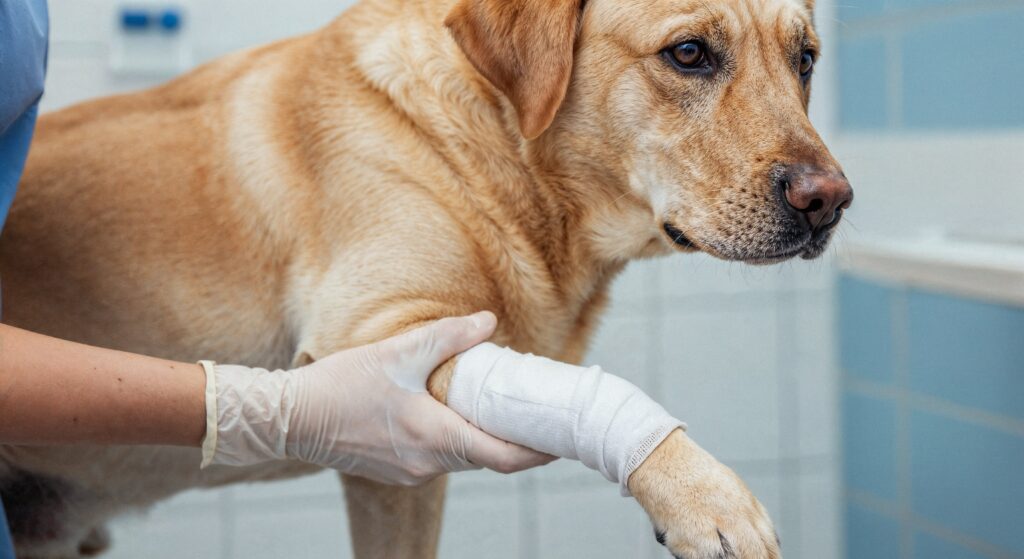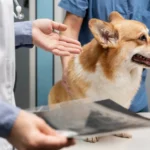
Contents
Pets are playful, curious and sometimes unpredictable, which unfortunately makes them prone to injuries. Recognizing trauma early is essential to prevent worsening conditions and ensure your furry companion receives timely care. Common injuries in pets often result from car accidents, hit-by-car situations, attacks from other animals, or falls from elevated surfaces such as stairs, furniture or balconies. Quick action paired with emergency veterinary care can make the difference between full recovery and long-term complications. By understanding the causes and warning signs, pet owners can better protect their companions and respond effectively during emergencies.
What are Common Pet Injuries?
Common pet injuries refer to the accidental harm or trauma pets experience during their daily activities. These injuries can happen at home, outdoors, or during play and may cause pain or limit mobility. They often require careful attention to ensure pets heal properly and remain comfortable. Prompt care and prevention are key to avoiding complications and keeping pets healthy and active.
Types of Common Injuries in Pets
Pets can experience a wide range of injuries, from minor scrapes to life-threatening trauma. Common pet injuries include soft tissue damage, fractures, bites, burns, head trauma and internal bleeding. While some injuries are obvious, others may be hidden, making it essential for pet owners to recognize warning signs and act quickly.
Sprains, Strains, and Soft Tissue Injuries
Sprains and strains are injuries to muscles, ligaments, or tendons, often caused by running, jumping or slipping on slick surfaces such as tile or wet floors. Dogs and cats may display limping, stiffness or difficulty moving a joint. Swelling, bruising or tenderness at the affected area is common. Early rest, controlled activity, and veterinary evaluation can prevent worsening of these injuries and promote proper healing.
Cuts, Scratches, and Lacerations
Cats and dogs frequently sustain cuts and lacerations from household hazards, sharp objects, or outdoor encounters. Examples include scrapes from cat trees, fences, broken glass or thorny bushes. Untreated lacerations can quickly become infected, leading to abscesses or systemic illness. Look for redness, pus, hot spots, or delayed wound healing. Prompt cleaning and professional evaluation reduce infection risk and ensure proper wound management.
Fractures and Dislocations
Broken bones and joint dislocations are among the most serious common injuries in pets. Fractures can occur in the femur, humerus, or smaller bones and are often caused by vehicle collisions, falls from height or animal attacks. Signs include dangling limbs, refusal to bear weight, visible bone misalignment, or extreme pain when touching the limb. Joint dislocations may mimic sprains but often require emergency veterinary attention to prevent permanent mobility problems.
Bite Wounds and Animal Attacks
Bites from other animals, dogs, cats or wildlife can cause deep punctures and lacerations. These injuries carry a high risk of bacterial infection, including Pasteurella or Staphylococcus species. Immediate first aid includes cleaning the wound, controlling bleeding and seeking emergency veterinary service to evaluate tissue damage, prevent infection, and administer vaccinations if necessary.
Head Trauma and Brain Injuries
Head injuries are frequently caused by falls, being hit by a car, or blunt force trauma. Signs of potential brain injury include muscle tremors, seizures, a wide-eyed or startled expression, unsteady gait, or sudden disorientation. Even if external wounds are minimal, internal brain trauma can be life-threatening and requires immediate professional evaluation.
Internal Injuries and Bleeding
Some injuries are not visible externally but can be equally dangerous. Internal trauma may affect the lungs, heart, liver, or abdomen, often occurring after blunt impact or vehicle accidents. Signs of internal injury include collapse, weakness, pale or discolored gums, blood in urine, vomiting or labored breathing. Immediate veterinary care is critical, as untreated internal bleeding can quickly become fatal.
Burns and Skin Damage
Pets can suffer thermal burns from hot surfaces or liquids and chemical burns from cleaning agents or toxins. Signs include patchy or scruffy fur, redness, swelling, pain or reluctance to move. Early veterinary intervention helps manage pain, prevent infection, and promote proper healing.
Heatstroke and Stress-Related Injuries
Pets exposed to extreme heat or overexertion during play can suffer heatstroke. Symptoms include heavy panting, collapse, bright red or bluish gums, vomiting and disorientation. Stress-related injuries can also occur from panic or anxiety, resulting in accidental falls or self-inflicted trauma. Immediate cooling, hydration and veterinary evaluation are essential for survival.
Recognizing these common pet injuries early allows pet owners to act quickly, provide first aid when appropriate, and seek professional veterinary care. Prompt attention often prevents long-term complications, improves recovery outcomes and can save your pet’s life.
Signs of Trauma or Internal Injury
Some injuries aren’t immediately visible. Red flags include:
- Abnormal gum color (blue, pale, yellow or bright red). Discoloration of gums can indicate poor oxygenation, internal bleeding, or shock, signaling a serious injury that requires immediate veterinary evaluation to prevent life-threatening complications.
- A pet suddenly avoiding movement, favoring one leg, or limping may have a fracture, sprain or soft tissue injury. Early assessment prevents worsening damage and supports faster recovery.
- Significant changes in eating or sleeping patterns may indicate internal trauma, pain or illness. Close monitoring and prompt veterinary care help identify hidden injuries before complications develop.
- Respiratory distress is a critical sign of trauma, airway obstruction or internal injury. Immediate evaluation is necessary to stabilize breathing and prevent further health deterioration.
- Gastrointestinal symptoms, abdominal swelling, or pain when touched can indicate internal bleeding, organ damage or trauma. Rapid veterinary assessment ensures early treatment and reduces serious risks.
- Sudden collapse, confusion, or unresponsiveness can signal head trauma, shock or severe internal injury. Immediate emergency care is essential to prevent permanent damage or death.
Early recognition ensures timely treatment, preventing complications or permanent damage. For more tips check out this guide on how to handle pet trauma before reaching emergency care.
How Pets Express Pain
Dogs:
Dogs display pain through both physical and behavioral changes:
Limping or guarding the abdomen: Dogs may limp, favor one leg, or protect their abdomen by tensing muscles, indicating internal or skeletal pain that requires immediate attention.
Licking wounds excessively or avoiding movement: Dogs may repeatedly lick injured areas or refuse to move, signaling localized pain, discomfort or distress needing evaluation and treatment.
Growling, whining, or anxious behavior: Changes in temperament, such as growling, whining, or general anxiety, often accompany physical pain and help indicate areas of discomfort.
Stiff gait or arched back: Altered posture, stiffness, or an arched back is a common sign of musculoskeletal or abdominal pain in dogs, signaling the need for veterinary care.
Cats:
Cats communicate discomfort through vocal, behavioral and posture changes, which can be subtle yet indicate significant pain requiring immediate attention.
Vocalizing through hissing, growling or yowling: Unusual vocal sounds such as hissing, growling, or yowling can signal fear, pain or stress in cats experiencing injuries or internal discomfort.
Hiding or avoiding litter box use: Pain may cause cats to hide or avoid routine activities, including litter box use, indicating internal discomfort or injury that should be assessed promptly.
Swatting or showing abnormal aggression: Cats in pain may display aggression, swatting at humans or other pets, as a defensive mechanism against perceived threats to painful areas.
Curling tightly or squinting eyes: Posture changes like curling into a tight ball or squinting eyes are common cat behaviors signaling distress or musculoskeletal discomfort.
Wide-eyed, flat-eared facial expressions: Cats often show pain through facial cues, including wide eyes and flat ears, reflecting fear, stress or injury.
Small breeds, like Papillons, are especially prone to limb fractures from jumping off furniture or cat trees, requiring extra supervision and preventive measures to avoid injury.
When to Seek Emergency Veterinary Care
Immediate veterinary attention is crucial if you notice any signs of serious injury in your pet. Symptoms such as internal bleeding, abnormal gum color, seizures, unconsciousness or head trauma require urgent evaluation. Breathing difficulties, choking or collapsed lungs also demand immediate care to prevent life-threatening complications. Large lacerations, puncture wounds or injuries resulting from severe animal attacks should never be ignored and worsening limping or suspected fractures indicate the need for prompt professional intervention. Early veterinary evaluation saves lives, prevents infection and significantly improves recovery outcomes for pets.
Importance of Early Veterinary Care
Early veterinary care is crucial for stabilizing common pet injuries, controlling pain and preventing secondary complications. Immediate assessment prevents infection, ensures proper bone alignment, and provides life-saving interventions in critical trauma cases. Quick action can mean the difference between full recovery and permanent disability.
At North MS Pet Emergency, our team offers 24/7 weekend care for pets experiencing trauma, fractures, internal injuries, burns or stress-related emergencies. Timely intervention saves lives and supports optimal recovery. If your pet shows any signs of injury or distress, contact us immediately for professional care.
FAQs
1. What are the most common pet injuries?
The most common pet injuries include fractures, sprains, cuts, lacerations, bite wounds, burns, head trauma and internal bleeding. Recognizing early warning signs is crucial to ensure timely veterinary care and prevent long-term complications.
2. How can I tell if my dog is traumatized by an attack?
A dog traumatized by attack may display trembling, hiding, excessive fear, growling or reluctance to move. Behavioral changes such as aggression or refusal to eat are also common and should prompt immediate veterinary evaluation.
3. What are the signs of internal trauma in dogs?
Signs of internal trauma in dogs include pale or abnormal gum color, collapse, lethargy, vomiting, bloating, labored breathing or blood in urine or stool. Prompt veterinary care is essential to prevent life-threatening complications.
4. Are there resources for learning first aid for pets?
Courses like First Aid for Pets, books such as Dog First Aid, or online tutorials can teach essential skills, including CPR, wound management, and stabilization techniques to handle minor injuries or emergencies before veterinary care.




